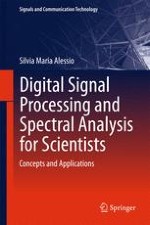2016 | OriginalPaper | Chapter
10. Non-Parametric Spectral Methods
Author : Silvia Maria Alessio
Published in: Digital Signal Processing and Spectral Analysis for Scientists
Publisher: Springer International Publishing
Activate our intelligent search to find suitable subject content or patents.
Select sections of text to find matching patents with Artificial Intelligence. powered by
Select sections of text to find additional relevant content using AI-assisted search. powered by
